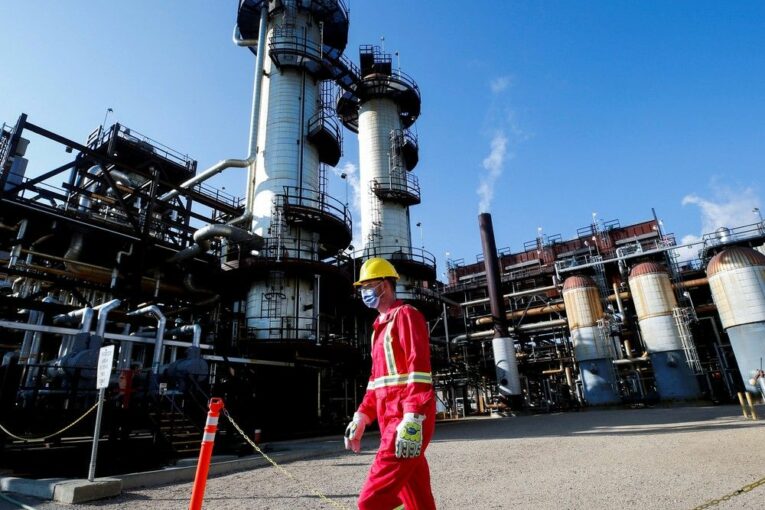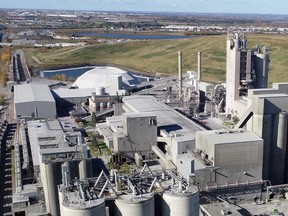
Close, and getting closer — but not quite close enough.
If there’s a simple way to describe what effect the new federal budget will have on proposed carbon capture, utilization and storage (CCUS) projects in Canada, the plan represents progress, says Enbridge CEO Greg Ebel.
However, the Calgary-based company isn’t ready to give the green light to its proposed Wabamun carbon hub project in Alberta — at least not yet.
“It was a step in the right direction, in terms of incentives. I still think there’s a ways to go that would make CCUS in Canada to be as economic . . . as what we see in the United States,” Ebel said in an interview this week.
“It’s just not quite there yet.”
A lineup of large CCUS projects are on the drawing board in Alberta that would capture carbon dioxide emissions and bury them deep underground or use them in industrial processes.
It would allow industry and the province — Alberta has the highest emissions in the country — to take big decarbonization steps as the country moves to a net-zero target by 2050.
Energy consultancy Wood Mackenzie is tracking 53 CCUS projects, hubs and expansions that have been proposed or are in various stages of development across Canada; 39 such ventures are in Alberta, representing billions of dollars in investment.
These plans include Enbridge’s Wabamun carbon hub — it’s partnering with Capital Power and cement manufacturer Heidelberg Materials — and a $16.5-billion CCUS development proposed by the Pathways Alliance, connecting oilsands operations to a storage hub near Cold Lake.
Such initiatives are essential to decarbonizing major industries in the province.
“CCUS is also going to help us increase the supply of oil and gas, hydrogen, critical minerals and, of course, low-carbon cement,” Alberta Liberal MP and Associate Finance Minister Randy Boissonnault said Wednesday at an announcement with Heidelberg about its carbon capture project in Edmonton.

Executives with Heidelberg and the federal government signed a memorandum of understanding to support building the world’s first carbon-neutral cement plant at the company’s Edmonton facility.
The $1.4-billion project would capture more than one million tonnes of CO2 a year, which would then be shipped to the Wabamun hub for storage.
Heidelberg officials have not yet made a final investment decision, but the company is busy with its design work and expects the project could be operating by late 2026.
“We’re very pleased to see the (federal) investment tax credit that was announced. And that was really a catalyst,” said Chris Ward, CEO of Heidelberg Materials North America.
While projects in Alberta are steadily progressing, few have received the official go-ahead.
Some companies have been waiting for details of Canada’s new investment tax credit for CCUS projects, which was first mentioned in the 2021 budget. Companies also wanted to see if the federal and provincial governments would narrow the gap between incentives offered in Canada and those available in the United States.
In last week’s budget, the federal government took more steps to promote clean energy investment and CCUS initiatives, but is it enough?
“I didn’t see anything in there on carbon capture that really gave us any more clarity,” said Alberta Energy Minister Peter Guthrie, whose government has also been pressed to assist such developments.
“I’m a bit frustrated.”
The Trudeau government announced it will move forward on carbon contracts for difference through the Canada Growth Fund, which should help lock in the future price for carbon or hydrogen.
The federal tax credit for CCUS projects is set at 50 per cent for investments in equipment to capture CO2, and 37.5 per cent for equipment used for transportation and storage.
In last week’s budget, several minor changes were made to the investment tax credit. The budget also pledged to take steps to accelerate the regulatory timelines facing major projects.
“The one thing that obviously would be helpful is just some certainty on the permitting/approval time frame,” Ebel said.
While Canada is offering an investment tax credit for capital expenditures, the U.S. is providing a tax credit of $85 for each tonne of stored CO2.
“The U.S. is going ‘full in’ on carrots, whereas Canada is relying a little bit more on that stick in the form of a carbon tax,” said Wood Mackenzie analyst Scott Norlin.
Recommended from Editorial
-

Varcoe: Oilsands giants warn Canada falling behind U.S. on carbon capture incentives
-

Timelines key as federal budget promises billions for green transition
-

Ottawa and Edmonton cement manufacturer sign preliminary deal on carbon capture
-

Varcoe: Birth of an industry amid race for carbon capture developments in Alberta
The Pathways Alliance group, representing major oilsands producers, welcomed some of the budget changes but wants to better understand the government’s plans surrounding carbon contracts for difference.
Meanwhile, Capital Power is examining its proposed carbon capture project, which would send up to three million tonnes of CO2 per year from the Genesee Generating Station to the Wabamun hub west of Edmonton.
Capital Power chief financial officer Sandra Haskins said the company supports carbon contracts for difference as a way to de-risk policy uncertainty.
The Edmonton-based company expects to make a final investment decision on its project, expected to cost $2.3 billion, in the fourth quarter of this year.
While these are positive signals, a report released this week by CIBC described the budget as “Canada’s carbon capture disadvantage — yet another missed opportunity.”
“As incremental incentives were left out of this budget cycle, we believe this presents a risk that Canada falls behind in its capacity to attract green capital,” said the report by analyst Dennis Fong.
At Enbridge, work continues on its Wabamun hub, including the drilling of a test well and evaluation of its pore space.
The pipeline giant also has a CCUS project in Texas, and Ebel expects the company will be able to do both developments.
In Alberta, capital costs for the carbon hub are still being determined and there’s a good possibility Enbridge and its partners will make a final investment decision within the next year.
“Look, it is high on our agenda,” said Ebel.
“In the next 12 months, I think all three of us will be able to say go-no go.”
Chris Varcoe is a Calgary Herald columnist.
You can read more of the news on source
